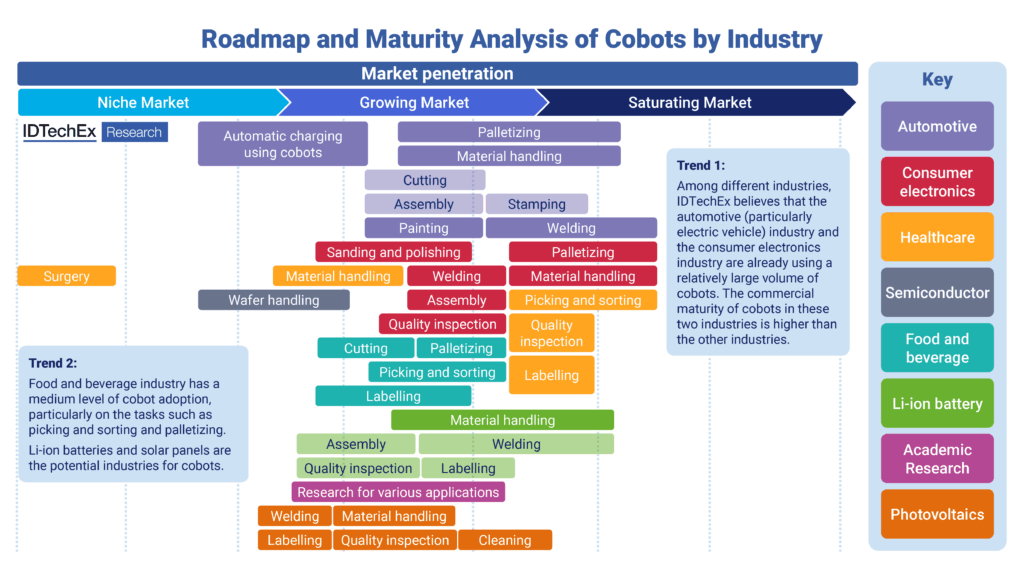Analysis of the cobots market penetration by different tasks and industries.
Collaborative robots (cobots), a type of lightweight and slow-moving robot designed to work next to human operators without a physical fence, have gained significant momentum thanks to their flexibility and the initiatives of bringing humans back to factories, industry 5.0, and many announcements from leading companies of reducing their carbon footprint. Cobots have found significant usage in the automotive industry for tasks ranging from car assembly to screwing and surface polishing. These cobots have demonstrated significant cost benefits and efficiency improvements. IDTechEx‘s “Collaborative Robots 2025-2045: Technologies, Players, and Markets” report takes a deep dive into these tasks, along with their pain points, technical & commercial barriers, as well as future opportunities.
Tasks for cobots in the automotive industry
The automotive industry is the most prominent application of cobots. Cobots can be used for multiple tasks including car assembly (e.g., welding, assembling dashboards, etc.), surface polishing, and screwing. With the increasing popularity of electric vehicles, many existing car product lines need retrofitting or reconstruction. Their key advantage lies in their ability to safely share workspaces with human operators. Unlike traditional industrial robots, which require complete isolation due to their speed, force, and potential safety risks, cobots operate at lower speeds and forces, with embedded safety features like force-limiting joints and advanced proximity sensors.
A significant pain point for automotive OEMs is production downtime due to robot malfunctions. Traditional robots require complete line shutdowns for human operators to enter the working area safely. In contrast, cobots can allow partial line operations or rapid intervention, reducing the cost of downtime. For example, producing a Tesla Model 3 at the Fremont factory takes around 90 minutes. The revenue loss can be substantial if a robot failure halts production for even a few hours. Cobots offer a way to maintain uptime and flexibility while ensuring safety.
Additionally, with the rise of electric vehicles (EVs), automakers must frequently retrofit or reconfigure existing production lines. Cobots’ plug-and-play capability and easy reprogrammability make them ideal for adapting to new workflows without requiring months of custom integration.
Technical capabilities that make cobots different
One of the most defining features of collaborative robots is their advanced force and torque sensing capabilities. Cobots are typically equipped with six-axis torque sensors embedded at each joint, allowing them to detect external forces with high precision, often within a sensitivity range of 0.1 to 0.5 Nm. This capability enables real-time feedback control, allowing the robot to stop immediately when encountering unexpected resistance, such as contact with a human or an obstacle. This intrinsic safety mechanism is critical for close human-robot interaction and also enables fine manipulation tasks. For example, in surface polishing or delicate part insertion in automotive assemblies, cobots can maintain a consistent pressure (e.g., 5 to 15 N) across surfaces, significantly improving finish quality and consistency.
Another major enabler of flexibility in cobots is machine vision and AI integration. Vision systems—either built-in or modular—allow cobots to perform real-time image analysis for object detection, part orientation, and even quality control. High-resolution industrial cameras paired with AI models enable cobots to identify defects, adapt to varying part geometries, and even adjust their path or grip accordingly. For instance, cobots used in car dashboard assembly can dynamically locate and align with pre-installed components, increasing accuracy without relying on fixed jigs.
Ease of programming is another cornerstone of cobot design. Unlike traditional industrial robots that often require proprietary scripting languages and specialist programmers, cobots feature intuitive programming interfaces. Many offer graphical user interfaces (GUIs) with drag-and-drop logic, and some support manual “lead-through teaching,” where an operator physically guides the arm through desired motions. This can cut deployment time by over 70%, and empowers shop-floor operators to reprogram tasks without needing robotics expertise.
Finally, cobots support modular end-effectors, making them highly versatile. These tools—such as grippers, electric screwdrivers, welding torches, sanding attachments, or suction cups—can often be swapped within 30 seconds to 2 minutes using quick-change adapters. This modularity allows one cobot to perform multiple tasks in a production cell, enhancing productivity while minimizing downtime and capital costs.
To find out more about IDTechEx’s “Collaborative Robots 2025-2045: Technologies, Players, and Markets” report, including downloadable sample pages, please visit www.IDTechEx.com/Cobots.
For the full portfolio of robotics market research available from IDTechEx, please see www.IDTechEx.com/Research/Robotics.
Yulin Wang
Senior Technology Analyst, IDTechEx
About IDTechEx
IDTechEx provides trusted independent research on emerging technologies and their markets. Since 1999, we have been helping our clients to understand new technologies, their supply chains, market requirements, opportunities and forecasts. For more information, contact [email protected] or visit www.IDTechEx.com.


